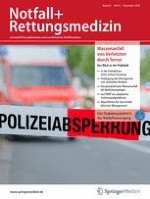17.10.2017 | Leitthema
Algorithmus für das initiale klinische Management bei einem Massenanfall von Verletzten
Erschienen in: Notfall + Rettungsmedizin | Ausgabe 6/2018
Einloggen, um Zugang zu erhaltenZusammenfassung
Ein Massenanfall von Verletzten (MANV) stellt eine besondere Herausforderung für alle Beteiligten dar. Während in der Präklinik Konzepte wie z. B. mSTaRT bereits fest etabliert sind, besteht im klinischen Bereich ein deutlicher Aufholbedarf. Besonders außergewöhnliche Schadenslagen wie Terrorangriffe oder Amokläufe mit zivilen Opfern erfordern gezielte Vorbereitungen. Mit der Vorstellung des von uns entwickelten Algorithmus für das initiale klinische Management bei einem MANV möchten wir die Notwendigkeit der Implementierung solcher Konzepte unterstreichen sowie anderen Kliniken ein an deren Bedingungen adaptierbares Schema zur Verfügung stellen. Komponenten des Algorithmus sind Sichtung der in der Klinik eintreffenden Patienten, Einteilung der zu Verfügung stehenden Räumlichkeiten sowie initiale Notfallmaßnahmen und Bildgebung, bis eine Entscheidung über die weitere Behandlung der Patienten getroffen werden kann. Inhaltlich basiert der Algorithmus auf aktueller wissenschaftlicher Evidenz aus Leitlinien und Fachpublikationen sowie anerkannten Behandlungskonzepten wie dem ABCDE-Schema gemäß ATLS®. Die Implementierung des Algorithmus kann jedoch nur als weiterer Schritt für einen erfolgreichen Umgang mit einem Großschadensereignis angesehen werden. Präklinische und innerklinische Handlungspläne sollten nahtlos ineinandergreifen und gemeinsam geübt sowie evaluiert werden.
Anzeige















